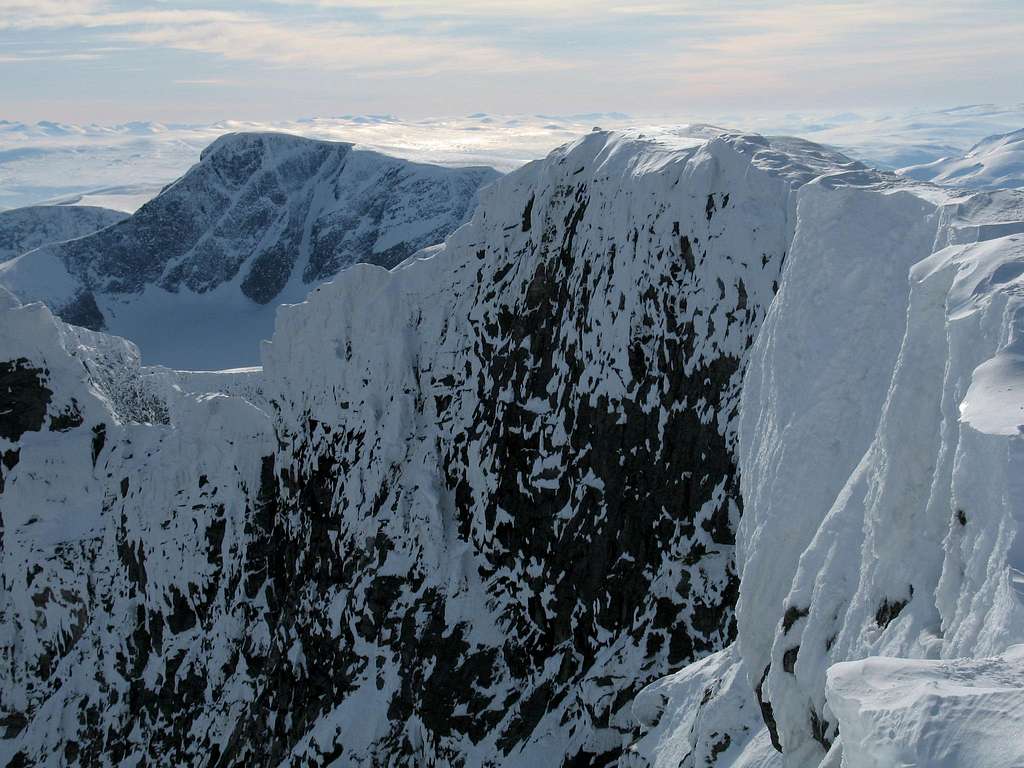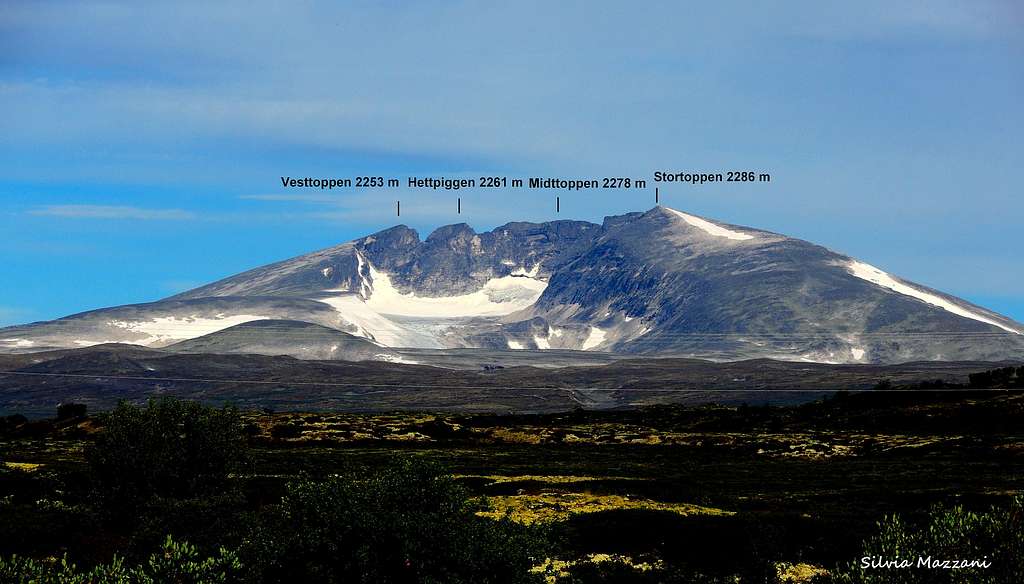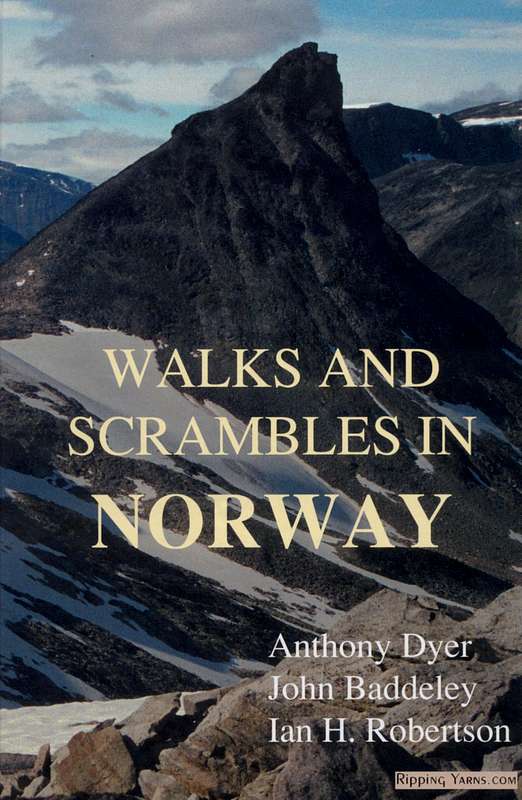-
 11914 Hits
11914 Hits
-
 77.3% Score
77.3% Score
-
 8 Votes
8 Votes
|
|
Mountain/Rock |
|---|---|
|
|
62.19000°N / 9.15000°E |
|
|
Hiking, Mountaineering, Scrambling, Skiing |
|
|
Spring, Summer, Fall |
|
|
7500 ft / 2286 m |
|
|
Overview
Snøhetta
Snøhetta 2286 m - whose name means the Snow Cap - is a superb mountain located in the Innlandet county, Dovre Kommune, and included inside the Dovrefjell-Sunndalsfjella National Park, a mountain area shared amongst the counties of Møre og Romsdald, Oppland and Sør-Trøndelag. There are 291 peaks in Norway with the magic elevation over sea level of 2,000 metres and Snøhetta is one of these, a landmark which cannot easily be forgotten. To be precise, it's the 24th mountain in order of height in Norway and the highest one outside the Jotunheimen range. Snøhetta is the highest summit in the Dovrefjell area, the second highest range after Jotunheimen in Norway. Snohetta includes somes small glaciers and four different tops are lined up on the summit crest: Stortoppen, the highest one, 2286 m, Midttoppen, 2278 m, Hettpiggen 2261 m, Vesttoppen 2253 m.

Dovrefjell is one the few places besides northern Canada and Greenland where it's possible to observe muskoxen. Muskoxen are one of the few mammals that are able to survive in a polar climate without hibernating. They have a special kind of hair which allows then to live in areas where the temperature often goes below -40°C. They dig the snow where it's not too deep and hard to find grass and lichens. Muskoxen have been intensively hunted in the 19th century, which has lead to their extinction in Alaska, Norway or Russia. Since then, they have been reintroduced in Norway, Quebec, Russia or Sweden, and the most important of these populations apart northern Canada and Greenland is located in Dovrefjell.

Midttoppen, Hettpiggen and Vesttoppen, even if not the highest summits, are the finest ones, because of - unfortunately - on Stortoppen there is a military building, a radio link station, originally installed by the Norwegian Army, which can initially disappoint those who reach the top. Anyhow, this particular is soon forgotten in comparison with the broadness of the panorama offered by the summit. Anyhow the Norwegian Defence Estates Agency is conducting the program to restore the original condition within the year 2020.

Getting There
The nearest town is Dombås, located South of Dovrefjell, just at the junction of E6 and E136 Highways (about 330 km. from Oslo).
Take the Oslo Trondheim train (a few trains a day) and stop at Kongsvoll station at about 900 m (ask for the stop to the train's crew before). From Oslo about 5 hours, from Trondheim 2 hours by train. It's also possible to drive there using the E6 between Oslo and Trondheim, which basically goes along the railroad. In spring 2007 the round-trip ticket for the train costs about 1000 norwegian Kr (1 euro=8,1 Kr)
Schedule below :
http://nsb.no/internet/diverse/rutetider/pdf/jan07/021_oslo_trondheim_dovre_07.pdf
http://www.nsb.no/internet/diverse/rutetider/pdf/jan07/021_oslo_trondheim_dovre_07.pdf
http://www.nsb.no/internet/diverse/rutetider/pdf/jan07/022_andalsnes_dombas_07.pdf
When to go there
Snohetta is located on the 62nd parallel, not very far from the polar arctic circle. So the weather can be very harsh there, from fall to spring, with strong winds and low temperatures. Also very short days from November to February, with only a few hours of daylight. On the opposite very long days from May to August, but also plenty of mosquitoes and mud.
Mountaineering: from mid-June to mid September
Ski-mountaineering: the best season could then be from late March to early May, when the temperatures beging to go up and there is still enough snow to have country-skiing.
Where to stay
There are a lot of good refuges (usually unstaffed) in the Dovrefjell area close to the Snohetta summit :
- Reinheim at 1350 m (keys to be asked before use),at the bottom of the northeast face,
- Amotdalshytta at 1300 m (keys to be asked before use),at the bottom of the northwest face,
- Gamle Reinheim at 1650 m, to be used only as an emergency shelter, at the bottom of the east face.
These refuges provide a excellent level of comfort, with available gas stoves, cuisine equipment, wood, private rooms of 4, living room, drying room, food... The price was about 260 norwegian Kr (1 euro=8,1 Kr)
in March 2007, per person per night (food is extra).
It's possible to reach Snohetta summit in half a day from every of these refuges.
External Links
For informations about muskoxen :
http://en.wikipedia.org/wiki/Musk_ox
http://www.hww.ca/hww2.asp?id=95
For informations about Snohetta :
http://en.wikipedia.org/wiki/Sn%C3%B8hetta_%28mountain%29
For weather forecasts (in Oppdal close to Snohetta) :
http://www.snow-forecast.com/resorts/Oppdal.shtml
How to go the top from Kongsvoll and Reinheim
From the railroad station take the path to the west, first going up through the forest. Shortly after the end of the forest, the trail flattens and you can see the entire length (more than 15km) of the valley leading to the Reinheim refuge. Pursue to the west by letting the stream on your left. After the Reinheim refuge, go south through a steeper slope to a pass at 1574 m, turn right to take to the west the long and moderatly steep slope going up to the top of Snohetta, marked by a radio link station.
Same way back to Reinheim and Kongsvoll.
Red tape
Snøhetta 2286 m is included inside the Dovrefjell-Sunndalsfjella National Park, extended in 2002.
No fees no permits required. Private cars are not allowed on the Snøheimveien road. Snøhetta is located inside the Dovrefjell-Sunndalsfjella National Park. You should take care of nature as usual within the boundaries of all the natural parks. The whole fauna and flora are protected. Don’t disturb the fauna in the area. The Reindeer are very easily disturbed, so do never try get close to them, while the Musk might become aggressive and attack in self-defence. Please keep the correct distance (at least 200 meters) from the animals.
Meteo
Guidebooks an maps
-Guidebooks
Walks and scrambles in Norway - Anthony Dyer, John Baddeley, Ian H. Robertson - Hiking, Scrambling and Mountaineering in Norway, an English guidebook covering Jotuheimen and several other areas in the Scandes -Ripping Yarns 2006 (ISBN 978-1904466253)
-Maps
1519-IV Snøhetta Statens Kartverk, Norge 1:50000



